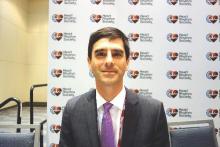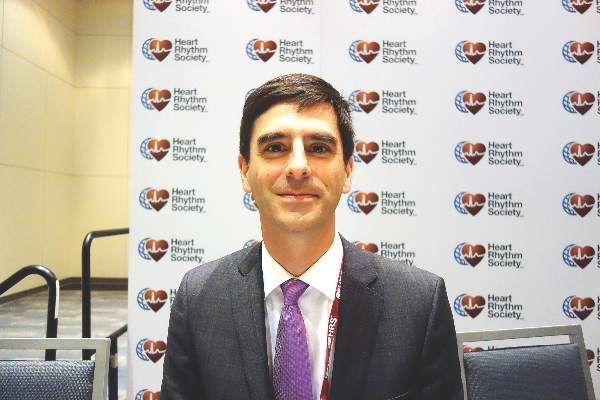User login
SAN FRANCISCO – Catheter ablation is a better option than antiarrhythmic drug escalation when patients with ventricular tachycardia (VT) fail standard first-line medical therapy, according to a 259-patient trial.
During a mean follow-up of 27.9 months, 59.1% (78) of patients randomized to ablation, but 68.5% (87) randomized to escalation, met the combined primary endpoint of death, ventricular tachycardia (VT) storm, or appropriate implantable cardioverter defibrillator shock (hazard ratio favoring ablation, 0.72; P = 0.04).
All the patients had ischemic cardiomyopathy secondary to myocardial infarct, as well as an implantable cardioverter defibrillator (ICD) and recurrent VT despite amiodarone in two-thirds and sotalol in the rest. “In this situation with the options we have available, catheter ablation is preferable,” lead investigator Dr. John Sapp, a cardiology professor at Dalhousie University in Halifax, N.S., said at the annual scientific sessions of the Heart Rhythm Society.
Guidelines already recommend ablation when antiarrhythmic drugs don’t do the job, but many clinicians opt for caution and escalate drug therapy instead; the two approaches have never been compared head to head. “This trial provides evidence that catheter ablation should be preferred over escalation of AAD [antiarrhythmic drug] therapy” to reduce “recurrent ventricular tachycardia,” Dr. Sapp and his colleagues concluded in their report, which was published online at the time of presentation (N Engl J Med. 2016 May 5. doi: 10.1056/NEJMoa1513614).
The benefit of ablation was seen only in patients on baseline amiodarone and was due entirely to fewer shocks and VT storms. There was no significant between-group difference in mortality, which was about 27% in both arms and mostly from cardiovascular causes. Dr. Sapp noted that the study wasn’t powered to detect a difference in mortality.
Three deaths were attributed to AAD in the escalation arm, two from pulmonary and one from hepatic complications. The authors didn’t attribute any deaths directly to ablation, but noted that there were two cardiac perforations and three cases of major bleeding in the ablation arm. Even so, treatment-related adverse events were significantly more common with escalation (51 vs. 22 in ablation patients) and occurred in more patients (39 and 20, respectively). VT that was undetectable by ICD persisted in 10.2% (13) of drug-escalated patient and 3% (4) of ablation patients.
In the patients randomly assigned to escalation, those on sotalol were switched to amiodarone 200 mg/day; amiodarone patients were either increased to more than 300 mg/day or, if already at that level, had mexiletine 600 mg/day added to their regimen.
The work was funded by the Canadian Institutes of Health Research, St. Jude Medical, and Biosense Webster. Dr. Sapp reported research grants from St. Jude, Biosense, Medtronic, and Philips.
SAN FRANCISCO – Catheter ablation is a better option than antiarrhythmic drug escalation when patients with ventricular tachycardia (VT) fail standard first-line medical therapy, according to a 259-patient trial.
During a mean follow-up of 27.9 months, 59.1% (78) of patients randomized to ablation, but 68.5% (87) randomized to escalation, met the combined primary endpoint of death, ventricular tachycardia (VT) storm, or appropriate implantable cardioverter defibrillator shock (hazard ratio favoring ablation, 0.72; P = 0.04).
All the patients had ischemic cardiomyopathy secondary to myocardial infarct, as well as an implantable cardioverter defibrillator (ICD) and recurrent VT despite amiodarone in two-thirds and sotalol in the rest. “In this situation with the options we have available, catheter ablation is preferable,” lead investigator Dr. John Sapp, a cardiology professor at Dalhousie University in Halifax, N.S., said at the annual scientific sessions of the Heart Rhythm Society.
Guidelines already recommend ablation when antiarrhythmic drugs don’t do the job, but many clinicians opt for caution and escalate drug therapy instead; the two approaches have never been compared head to head. “This trial provides evidence that catheter ablation should be preferred over escalation of AAD [antiarrhythmic drug] therapy” to reduce “recurrent ventricular tachycardia,” Dr. Sapp and his colleagues concluded in their report, which was published online at the time of presentation (N Engl J Med. 2016 May 5. doi: 10.1056/NEJMoa1513614).
The benefit of ablation was seen only in patients on baseline amiodarone and was due entirely to fewer shocks and VT storms. There was no significant between-group difference in mortality, which was about 27% in both arms and mostly from cardiovascular causes. Dr. Sapp noted that the study wasn’t powered to detect a difference in mortality.
Three deaths were attributed to AAD in the escalation arm, two from pulmonary and one from hepatic complications. The authors didn’t attribute any deaths directly to ablation, but noted that there were two cardiac perforations and three cases of major bleeding in the ablation arm. Even so, treatment-related adverse events were significantly more common with escalation (51 vs. 22 in ablation patients) and occurred in more patients (39 and 20, respectively). VT that was undetectable by ICD persisted in 10.2% (13) of drug-escalated patient and 3% (4) of ablation patients.
In the patients randomly assigned to escalation, those on sotalol were switched to amiodarone 200 mg/day; amiodarone patients were either increased to more than 300 mg/day or, if already at that level, had mexiletine 600 mg/day added to their regimen.
The work was funded by the Canadian Institutes of Health Research, St. Jude Medical, and Biosense Webster. Dr. Sapp reported research grants from St. Jude, Biosense, Medtronic, and Philips.
SAN FRANCISCO – Catheter ablation is a better option than antiarrhythmic drug escalation when patients with ventricular tachycardia (VT) fail standard first-line medical therapy, according to a 259-patient trial.
During a mean follow-up of 27.9 months, 59.1% (78) of patients randomized to ablation, but 68.5% (87) randomized to escalation, met the combined primary endpoint of death, ventricular tachycardia (VT) storm, or appropriate implantable cardioverter defibrillator shock (hazard ratio favoring ablation, 0.72; P = 0.04).
All the patients had ischemic cardiomyopathy secondary to myocardial infarct, as well as an implantable cardioverter defibrillator (ICD) and recurrent VT despite amiodarone in two-thirds and sotalol in the rest. “In this situation with the options we have available, catheter ablation is preferable,” lead investigator Dr. John Sapp, a cardiology professor at Dalhousie University in Halifax, N.S., said at the annual scientific sessions of the Heart Rhythm Society.
Guidelines already recommend ablation when antiarrhythmic drugs don’t do the job, but many clinicians opt for caution and escalate drug therapy instead; the two approaches have never been compared head to head. “This trial provides evidence that catheter ablation should be preferred over escalation of AAD [antiarrhythmic drug] therapy” to reduce “recurrent ventricular tachycardia,” Dr. Sapp and his colleagues concluded in their report, which was published online at the time of presentation (N Engl J Med. 2016 May 5. doi: 10.1056/NEJMoa1513614).
The benefit of ablation was seen only in patients on baseline amiodarone and was due entirely to fewer shocks and VT storms. There was no significant between-group difference in mortality, which was about 27% in both arms and mostly from cardiovascular causes. Dr. Sapp noted that the study wasn’t powered to detect a difference in mortality.
Three deaths were attributed to AAD in the escalation arm, two from pulmonary and one from hepatic complications. The authors didn’t attribute any deaths directly to ablation, but noted that there were two cardiac perforations and three cases of major bleeding in the ablation arm. Even so, treatment-related adverse events were significantly more common with escalation (51 vs. 22 in ablation patients) and occurred in more patients (39 and 20, respectively). VT that was undetectable by ICD persisted in 10.2% (13) of drug-escalated patient and 3% (4) of ablation patients.
In the patients randomly assigned to escalation, those on sotalol were switched to amiodarone 200 mg/day; amiodarone patients were either increased to more than 300 mg/day or, if already at that level, had mexiletine 600 mg/day added to their regimen.
The work was funded by the Canadian Institutes of Health Research, St. Jude Medical, and Biosense Webster. Dr. Sapp reported research grants from St. Jude, Biosense, Medtronic, and Philips.
AT HEART RHYTHM 2016
Key clinical point: Catheter ablation is a better option than antiarrhythmic drug escalation when ventricular tachycardia patients fail standard first-line medical therapy.
Major finding: During a mean follow-up of 27.9 months, 59.1% (78) of patients randomized to ablation in the study, but 68.5% (87) randomized to escalation, met the combined primary endpoint of death, ventricular tachycardia storm, or appropriate implantable cardioverter defibrillator shock (HR favoring ablation, 0.72; P = 0.04).
Disclosures: The work was funded by the Canadian Institutes of Health Research, St. Jude Medical, and Biosense Webster. The lead investigator reported research grants from St. Jude, Biosense, Medtronic, and Philips.

